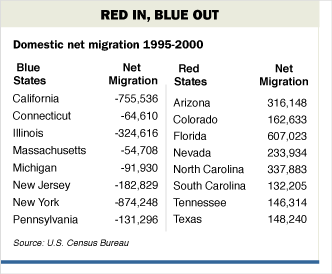VOTING WITH THEIR FEET
Daniel Henniger reports a mass exodus of people from “blue” states to “red” states.

When the Los Angeles Times published a story on the outflow, it didn’t have much trouble identifying the reason: The exodus is economic. In the world’s stalest states, such as Germany or Japan, people faced with cost-of-living waters rising to choking levels turn numb and go nowhere. But here in the U.S. moving on is a tradition, and today we have Web sites to reveal a suitable refuge from state political cultures intent on keeping the spending and tax spigot open.
Monstermoving.com lets you discover relative buying power if you lived somewhere else. Let’s type in L.A. and Tucson, just next door: “A salary of $30,000 in Los Angeles has the same buying power that a salary of $13,448 has in Tucson.” For Las Vegas the figure is $13,241. If on top of this they elect a Gray Davis governor, why stay?
New Yorkers’ third-favorite refugee camp is North Carolina. Easy to see why: You’ve got to earn $45,000 in the Big Apple to buy what $7,191 gets in Durham. As the Census report dryly puts it: “Five times as many people moved from New York to North Carolina as moved in the opposite direction.” Yes, retirees go to Florida, but the size of the flow is mind-boggling; in five years, 308,000 New Yorkers went there. It is now economically irrational for a middle-class person to retire in New York City.
If owning a home is central to the American dream, the blue states are becoming a nightmare. Realtor.com lets you learn why the dream is turning red: a three-bedroom house that costs $285,000 in L.A. is $155,725 in Tucson.
New York City’s hostility to 20-something apartment seekers, the seed-corn of its economy, is legendary. But a two-bedroom apartment goes for $760 in Richmond, Va., and $895 in Nashville, Tenn. For those prices you can’t sleep on the street in New York. Many young New Yorkers spend 50% of their before-tax income on rent. Of the 10 states with the highest combined tax burden, eight are blue states, according to the Tax Foundation.
Having moved only a year ago from one of the lowest cost of living states, Alabama, the the D.C. exurbs of Northern Virginia–opposite the general trend–I can certainly sympathize with this problem. Of course, salaries are also higher in more expensive areas, if not always enough to compensate for the differential cost of housing and taxation.
The linkage to “red” and “blue” states is not somewhat misleading, however. It certainly doesn’t follow that the country therefore becomes more “red” as a result of this migration. Indeed, Colorado, Florida, and the Carolinas are becoming less Republican over time–largely as a result of this migration pattern. While some people who move from, say, New York to Texas in order to buy a more substantial house and escape oppressive taxes will thereby be more sympathetic to Republicans, most will maintain their longstanding party affiliations in their new locale.
(Hat tip: Robert Prather)




$45,000 to $7,191? Is that just housing? It certainly couldn’t be overall purchasing.
At any rate, I might add that it’s not at all clear that the “most productive” citizens are the ones moving out, as much as Henniger might like to believe it. Rather, it’s the people who can’t afford housing. In fact, among immigrants, the census bureau reports that migrants out of California to other states are younger and poorer than the ones who stay.
In any case, as soon as Henniger is willing to refund all the extra tax dollars that us hardworking blue staters pay to subsidize the red staters, just let me know. We could use the money here in California.
I’ve played around with those moving calculators and usually get very strange results–either radical differences beyond imagination or rather small differences when larger ones would seem reasonable.
I don’t know of anyplace where $7,191 is a living wage. But I’d say $30,000 would go further in Alabama than $60,000 would in Manhattan or L.A. (not Lower Alabama, but the other one).
In Montgomery, Alabama, $150,000 will buy a quite nice 3-bedroom home with a decent sized yard. In Washington, D.C., it would cost $2 million or so to get something comparable–if you could find such a place for sale. Even 35-40 miles out, in places that were farmland a decade ago, a decent single family home goes for $500,000 at a bare minimum. And that’s not apples-to-apples, in that the place out here would be a three-story construction rather than the far more convenient one-story ranch style found in most of the country. And forget about a yard. In most of the country, a third of one’s pre-tax income is a reasonable amount to spend on a home, including utilities, taxes, etc. In a handful of cities, though, it’s over half one’s income.
Now, for me, the trade-offs have been worthwhile. There are fewer opportunities in Montgomery and frankly not all that much to spend one’s money on.
The net state migration statistic is incredibly misleading in the case of California. Remember, it only measures migration that begins and ends in a US state. In the same time period, California’s population just *rose* 14% (or 4.1 million people) – hardly a state turning into a ghost town because of a high cost of living. Just imagine what California would be like if *another* three-quarters of a million people had stayed there.
In fact, California’s high immigration rate is probably one of the reasons for the net state migration – immigrants are using California as a starting point before moving to other states. With roughly 4.8 million immigrants, it doesn’t take that many of them trying another state to create a big shift in net migration.
http://www.post-gazette.com/pg/03218/209213.stm has the statistics I cite, though they also have the same misleading spin.